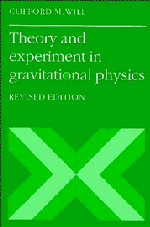Book contents
- Frontmatter
- Contents
- Preface to Revised Edition
- Preface to First Edition
- 1 Introduction
- 2 The Einstein Equivalence Principle and the Foundations of Gravitation Theory
- 3 Gravitation as a Geometric Phenomenon
- 4 The Parametrized Post-Newtonian Formalism
- 5 Post-Newtonian Limits of Alternative Metric Theories of Gravity
- 6 Equations of Motion in the PPN Formalism
- 7 The Classical Tests
- 8 Tests of the Strong Equivalence Principle
- 9 Other Tests of Post-Newtonian Gravity
- 10 Gravitational Radiation as a Tool for Testing Relativistic Gravity
- 11 Structure and Motion of Compact Objects in Alternative Theories of Gravity
- 12 The Binary Pulsar
- 13 Cosmological Tests
- 14 An Update
- References
- References to Chapter 14
- Index
Preface to First Edition
Published online by Cambridge University Press: 04 April 2011
- Frontmatter
- Contents
- Preface to Revised Edition
- Preface to First Edition
- 1 Introduction
- 2 The Einstein Equivalence Principle and the Foundations of Gravitation Theory
- 3 Gravitation as a Geometric Phenomenon
- 4 The Parametrized Post-Newtonian Formalism
- 5 Post-Newtonian Limits of Alternative Metric Theories of Gravity
- 6 Equations of Motion in the PPN Formalism
- 7 The Classical Tests
- 8 Tests of the Strong Equivalence Principle
- 9 Other Tests of Post-Newtonian Gravity
- 10 Gravitational Radiation as a Tool for Testing Relativistic Gravity
- 11 Structure and Motion of Compact Objects in Alternative Theories of Gravity
- 12 The Binary Pulsar
- 13 Cosmological Tests
- 14 An Update
- References
- References to Chapter 14
- Index
Summary
For over half a century, the general theory of relativity has stood as a monument to the genius of Albert Einstein. It has altered forever our view of the nature of space and time, and has forced us to grapple with the question of the birth and fate of the universe. Yet, despite its subsequently great influence on scientific thought, general relativity was supported initially by very meager observational evidence. It has only been in the last two decades that a technological revolution has brought about a confrontation between general relativity and experiment at unprecedented levels of accuracy. It is not unusual to attain precise measurements within a fraction of a percent (and better) of the minuscule effects predicted by general relativity for the solar system.
To keep pace with these technological advances, gravitation theorists have developed a variety of mathematical tools to analyze the new high precision results, and to develop new suggestions for future experiments made possible by further technological advances. The same tools are used to compare and contrast general relativity with its many competing theories of gravitation, to classify gravitational theories, and to understand the physical and observable consequences of such theories.
The first such mathematical tool to be thoroughly developed was a “theory of metric theories of gravity” known as the Parametrized Post-Newtonian (PPN) formalism, which was suited ideally to analyzing solar system tests of gravitational theories.
- Type
- Chapter
- Information
- Theory and Experiment in Gravitational Physics , pp. xv - xviPublisher: Cambridge University PressPrint publication year: 1993

